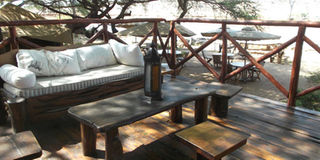Samburu’s little luxurious hideout

Elephant Bedroom Camp PHOTO| Rupi Mangat
What you need to know:
A few of the big elephants in the herd are collared to track them beyond the boundaries of the reserve. In a world that is fast-changing and with humans edging on to wild spaces, wildlife researchers are stepping in with the latest in modern technology to map elephants’ migration routes to safeguard them.
“It’s a great time for the lions,” adds Shivani Bhalla, founder of Ewaso Lions, as we enjoy a sumptuous lunch by the sandy banks of the river that is in low flow.
“The lions wait for the prey by the river knowing that something will come along soon.”
A herd of elephants graze by the river that is the life-lung of Kenya’s northern arid lands – the Ewaso Nyiro. The drought has been biting and with almost no water beyond the brown river, it has a magnetic draw for both predator and prey.
In a space of a few metres, we topple into Elephant Bedroom Camp that blends in with the colours of the sun-bleached grasses that elephants trample on, on their way to the river.
“Elephants have right of way here,” says Naguib Popat of Samburu’s little luxurious hideout.
“There are no fences around the camp to hamper their movement,” he adds.
A few of the big elephants in the herd are collared to track them beyond the boundaries of the reserve. In a world that is fast-changing and with humans edging on to wild spaces, wildlife researchers are stepping in with the latest in modern technology to map elephants’ migration routes to safeguard them.
“It’s a great time for the lions,” adds Shivani Bhalla, founder of Ewaso Lions, as we enjoy a sumptuous lunch by the sandy banks of the river that is in low flow.
“The lions wait for the prey by the river knowing that something will come along soon.”
The young woman came to study lions for her PhD for three weeks at Westgate Conservancy neighbouring Samburu National Reserve in 2007.
“I’m still here,” she says with a laugh.
In 2007, Ewaso Lions recorded 11 lions. By mid-2014, 40 have been recorded. Her secret? “For a long time, I thought lion conservation was all about working in the protected areas, but I soon came to learn that it’s about people who live with the lions. It’s about working with the communities,” she reveals
Finished with lunch and enjoying the river view from the raised deck of the lounge, we see a grey-headed kingfisher flitting to the river while a cardinal woodpecker hammers away on the acacia growing through the deck. At such close quarters there’s no need for binoculars.
TOO SMALL FOR LIONS
“The reserves are too small for the lions,” Bhalla continues. “Samburu, Buffalo Springs and Shaba cover 530 square kilometres. So we’re now covering conservancies around the reserves like Westgate and others that span 2, 000 square kilometres.”
It’s fascinating to learn about the northern dryland lions. “Our males don’t have manes, and they are smaller and sleeker than the Mara ones,” says the lion researcher.
It’s a lazy afternoon with a strong wind rustling the tall doum palms and the acacias. Out on a game drive along the plains and the massifs of the reserve with the iconic Ol Lolokwe the loaf-shaped mountain in the horizon, Dr Luca Borghesio, a forest biologist and ornithologist studying the little-known massif of Mathews Range beyond Samburu, and who runs the blog www.drlivsblog.blogspot.com, explains the winds.
“The mountain air is cool while the air on the plains is hot. During the day, hot air expands and cold air contracts. So there’s a flow of air from the low plains to the mountains. At night, it equalises.” That explains the still night air.
Samburu’s signature wildlife dots the landscape – the reticulated giraffe and Beisa oryx.
A herd of Grevy’s zebra graze on the plains. Larger with narrow stripes and more handsome than the common zebra, Kenya’s northern rangelands are their last stronghold. A clutch of Somali ostrich with purple legs and necks look stately.
But it’s even more fascinating to look for rare and little-known wildlife like the desert warthog and Gunther’s dikdik. We spot the desert warthog. Instead of huge warts on the side of its head like the common warthog, the desert breed have nondescript bumps sloping down. Tiny Kirk’s dikdik stay close to the thick bushes but Gunther’s dikdik remain elusive.
We chance upon a clutch of vultures by the river. Well-fed on the carcass of the lion-kill, this healthy bunch has cleaned the spot keeping the plains free of rotting carcasses and diseases.
“We don’t have a problem with poisoning,” says Moses Lolmodooni, Samburu National Reserve’s warden in charge of tourism. In other parts of Kenya, vulture populations have reduced by 95 per cent due to poisoning.
Well into the night, as we snuggle into our tent with a plunge pool on the deck, a lion roars and a hyena cackles. In the first light of day, troops of baboon clamber down the doum palms and scamper around the trumpeting elephants while huge flocks of beautifully patterned vulturine guineafowl run to the river for a morning drink.
It’s a nice spot to be in at Elephant Bedroom Camp.




